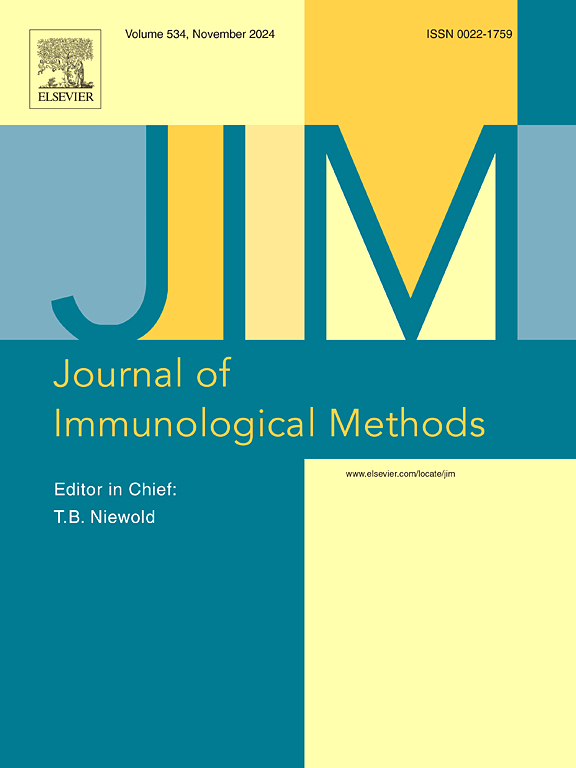CAR binding efficacy and off-target interactions for common CAR detection reagents
IF 1.6
4区 医学
Q4 BIOCHEMICAL RESEARCH METHODS
引用次数: 0
Abstract
Background
Chimeric Antigen Receptor (CAR)-T cell therapy is a highly innovative form of cell-based immunotherapy. To expand CAR-T therapies into additional disease indications, identification of novel tumor antigens and grafting of CARs on other types of immune cells, such as macrophages and natural killer (NK) cells are being pursued. Therefore, as this treatment modality continues to evolve, there is a need for highly specific detection reagents to interrogate CAR surface expression.
Methods/Objectives
This study uses flow cytometry to compare the ability of various commercially available CAR detection reagents' to detect CAR constructs containing distinct hinges, linker sequences, and scFv designs. Furthermore, interrogation off-target interactions were performed within a PBMC matrix.
Results
All antibody-based CAR detection reagents demonstrated specificity and robust signal in stable CAR-Jurkat cell lines and primary human CAR-T cells. Protein L only detected anti-CD20 (Leu16) scFv-based CAR; off-target non-CAR staining was observed in non-transduced human PBMCs. Detection using recombinant protein antigen provides clean results in single-stain samples for CD19 and BMCA proteins, though CD20 did not produce positive staining in anti-CD20 CARs. Additionally, in live human PBMCs, false-positive signals may be observed for antibody conjugates due to the binding of human Fc receptors to IgG.
Conclusions
CAR idiotype antibodies, recombinant antigens, and anti-linker antibodies were able to provide specific and robust detection of CAR-expressing cells. However, the utility of both idiotype antibodies and recombinant antigens is limited to CARs targeting specific antigens. The anti-linker antibodies enable universal and broad detection of CARs independent of target antigens.
常用CAR检测试剂的CAR结合效果及脱靶相互作用
嵌合抗原受体(CAR)-T细胞疗法是一种高度创新的细胞免疫疗法。为了将CAR-T疗法扩展到更多的疾病适应症,人们正在研究新的肿瘤抗原的鉴定以及将CAR-T移植到其他类型的免疫细胞上,如巨噬细胞和自然杀伤(NK)细胞。因此,随着这种治疗方式的不断发展,需要高度特异性的检测试剂来检测CAR表面的表达。方法/目的本研究采用流式细胞术比较各种市售CAR检测试剂检测含有不同铰链、连接子序列和scFv设计的CAR构建体的能力。此外,询问脱靶相互作用在PBMC矩阵中进行。结果所有基于抗体的CAR- t检测试剂在稳定的CAR- jurkat细胞系和原代人CAR- t细胞中均表现出特异性和强信号。蛋白L仅检测抗cd20 (Leu16) scFv-based CAR;在未转导的人pbmc中观察到脱靶非car染色。使用重组蛋白抗原检测CD19和BMCA蛋白在单染色样品中提供了干净的结果,尽管CD20在抗CD20 car中没有产生阳性染色。此外,在活的人pbmc中,由于人Fc受体与IgG结合,可能会观察到抗体偶联物的假阳性信号。结论scar独特型抗体、重组抗原和抗连接体抗体能够对car表达细胞提供特异性和鲁棒性检测。然而,独特型抗体和重组抗原的应用仅限于靶向特定抗原的car。抗连接体抗体能够普遍和广泛地检测独立于靶抗原的car。
本文章由计算机程序翻译,如有差异,请以英文原文为准。
求助全文
约1分钟内获得全文
求助全文
来源期刊
CiteScore
4.10
自引率
0.00%
发文量
120
审稿时长
3 months
期刊介绍:
The Journal of Immunological Methods is devoted to covering techniques for: (1) Quantitating and detecting antibodies and/or antigens. (2) Purifying immunoglobulins, lymphokines and other molecules of the immune system. (3) Isolating antigens and other substances important in immunological processes. (4) Labelling antigens and antibodies. (5) Localizing antigens and/or antibodies in tissues and cells. (6) Detecting, and fractionating immunocompetent cells. (7) Assaying for cellular immunity. (8) Documenting cell-cell interactions. (9) Initiating immunity and unresponsiveness. (10) Transplanting tissues. (11) Studying items closely related to immunity such as complement, reticuloendothelial system and others. (12) Molecular techniques for studying immune cells and their receptors. (13) Imaging of the immune system. (14) Methods for production or their fragments in eukaryotic and prokaryotic cells.
In addition the journal will publish articles on novel methods for analysing the organization, structure and expression of genes for immunologically important molecules such as immunoglobulins, T cell receptors and accessory molecules involved in antigen recognition, processing and presentation. Submitted full length manuscripts should describe new methods of broad applicability to immunology and not simply the application of an established method to a particular substance - although papers describing such applications may be considered for publication as a short Technical Note. Review articles will also be published by the Journal of Immunological Methods. In general these manuscripts are by solicitation however anyone interested in submitting a review can contact the Reviews Editor and provide an outline of the proposed review.

 求助内容:
求助内容: 应助结果提醒方式:
应助结果提醒方式:


